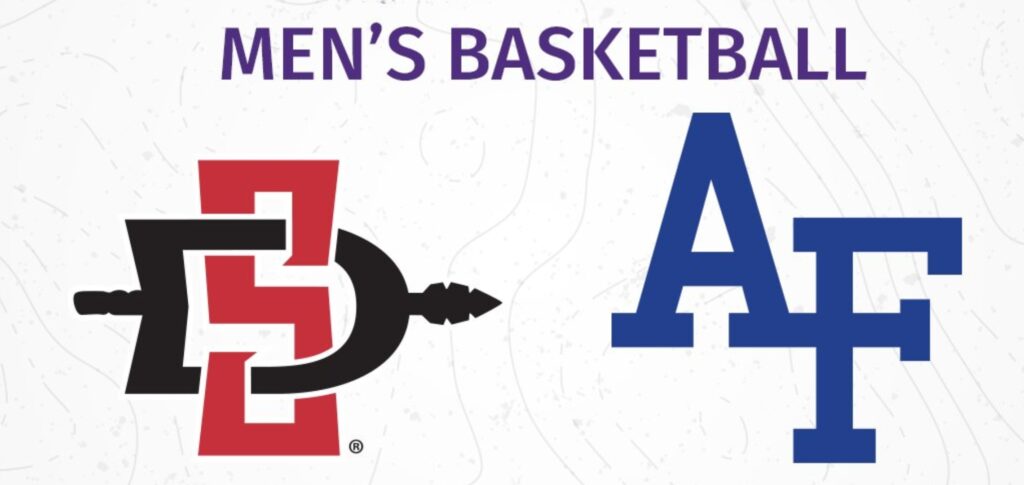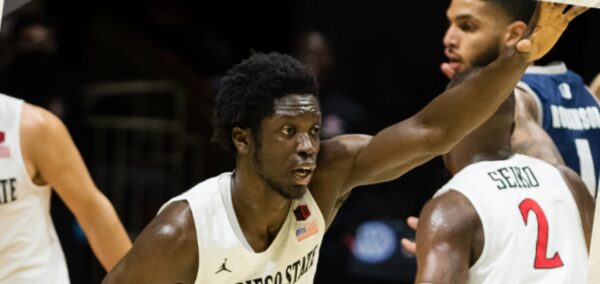Takeaways from the Air Force series for SDSU

NCAA Logos

The Aztecs seem to be back on track after two dominating wins over Air Force. They improved in the NET from 39 (on the bubble) to 31 (not guaranteed, but solidly in.) The Aztec currently appear on 65 of the 77 brackets tallied at bracketmatrix.com and average out to an 11 seed. Beating Air Force in and of itself isn’t a resume builder, but dominating them helped out the NET ranking. Most importantly, they didn’t lose, and as long as the Aztecs don’t lose any bad games, they’ll have a shot.
What did we learn about the Aztecs’ last series?
1. Consistency (or lack thereof)
The inconsistency of this team is the most frustrating thing about them. When they’re on their game, they can compete with just about anyone, and they absolutely destroy lesser teams. So far, they have a 37 point win over Air Force, a 25 point win over a good UCLA team, and a 25 point win over a solid St. Mary’s team.
52-16 is the third-largest halftime lead in the history of the Mountain West conference btw…
— Jon Schaeffer (@jonschaeffer) January 23, 2021
They have accomplished one of the largest halftime leads in conference history. Granted, it was against a weak Air Force team, but is anyone really going to make that argument and pretend that a good team has never faced a bad team in the 20+ years of conference play? The announcers also mentioned it was the largest lead on the road in MW history. At elevation, no less. So it was a dominant performance the likes of which haven’t been seen in this conference.
A couple of weeks ago, though, the Aztecs became the first team to give up a 26 point lead in a conference game. So this team has set records on both ends of the spectrum this season.
Some of the consistency issues happen over the course of a game too. You can’t give up a 26 point lead if you don’t first acquire a 26 point lead. They were hot to start that game and played poorly to finish it. In the second game against Utah State, they played pretty well in the first half, built up a 10 point lead, and gave it all away in the first 4 minutes of the second half.
This can be a dangerous team come conference tournament time when everyone is (hopefully) healthy and hopefully in a groove after not having a summer training camp. If they can find a way to play at 80%-90% of how they played against Air Force (minus the last 10 minutes of game 1), but do it every game for 40 minutes, they’ll be able to make some noise.
2. Free Throws
Earlier in the year, this was a good free-throw shooting team. A lot of that was due to Matt Mitchell drawing so much contact and making free throws afterward. The Aztecs shot 46.7% from the charity stripe in the second game against Utah State and 54.2% in the first game against Air Force. The main difference has been the players taking the shots. Mitchell was able to get into the lane and draw contact by facing up his opponent in the post. Bigs like Mensah and Arop have shown flashes of being able to draw contact in their own way but aren’t nearly as good from the line as Mitchell is. Schakel and Gomez are great free-throw shooters, but it’s hard to draw contact when your game is built around jump shots rather than finishing inside.
The biggest culprit is Keshad Johnson. In his limited minutes, he’s shown an ability to draw contact. He is drawing 5.3 fouls per 40 minutes, according to KenPom. Mensah is drawing 5.8, and Mitchell is drawing 6.9. Johnson’s free throw rate is an absurd 95.5% in Div. 1 games. Despite all that, Keshad is shooting only 42.9% from the line so far this season. That results in a lot of points being left off the scoreboard.
Keshad isn’t alone, though. Arop is only shooting 54.2% so far, Mensah is at 59.6%, and Pulliam is shooting 64.7%. Those are all pretty bad relative to their positions. Basically, the players drawing the most fouls need to make more free throws. Drawing fouls can have some benefit even without made free throws, but it’s so much better when you get to add points on the board as well. Mitchell returning in the second game helped, and as he increases his minutes, free throws overall will be less of a concern, but those players still need to improve so easy points aren’t missed.
3. Is Jordan Schakel back?
In the Nevada series, Schakel scored 15 points on 16 shots. In the Utah State series, Schakel managed to score 19 points on 19 shots. That is not up to his standard of efficiency. Against Air Force, those numbers improved to 42 points on 30 shots, which is much better. Is this a sign of things to come, though?
Variance (or luck) is definitely a thing in college basketball. Shooters can have hot and cold streaks caused by all sorts of different factors. The question moving forward is, has Schakel moved out of a cold streak, or was the cold streak forced by the opposing teams?
Opposing teams have learned to key in on Jordan Schakel and not let him get hot because when he does, he can fill up a box score really quick. Nevada and Utah State players managed to stay attached to Schakel the whole game and not give him many chances at open shots. Things started to change a little during the second Utah State game, as Schakel started to play more aggressively and finished 4-4 from inside the arc.
He followed that up with two great performances against Air Force. Air Force played a different defensive scheme, though, and it seemed much easier for Schakel to get open looks. When opposing teams return to making sure Schakel can’t get open, how will he respond? The second game against Utah State suggests he can use the other teams’ aggressiveness against them, and maybe that was the turning point for his cold streak. Similarly, the two games against Air Force may turn out to be fools gold.
The next series is against Wyoming, which has one of the nation’s worst defenses. They should be trying to deny Schakel the ball more than Air Force did, though. It’s a great opportunity for Schakel to start to refine his attacks to the basket and sharpen those skills in order to use them against tougher opponents. We’ll need more evidence to see if Schakel is back offensively, but the future looks promising.
4. Starting lineup heading forward
With Mitchell out the first game and on a minutes restriction the second game, the Aztecs had a question about who should start. The emergence of Lamont Butler also put some pressure to make the right decision. During the week, Coach Dutcher mentioned that after the Utah State series, he asked his five assistants who they thought should start, and he got four different answers.
There are many arguments for many players. Everyone brings a different skill set. Figuring out the players best compliment each other and how to balance out skillsets over 40 minutes is a tough job. Against Air Force, the starters were Pulliam, Gomez, Butler, Schakel, and Mensah. That lineup performed poorly, according to evanmiya.com. It’s a small sample, but they got outscored by 18 points per 100 possessions. As Mitchell gets, healthy someone will need to step down again to make room for him in the starting 5. It definitely won’t be Schakel or Mensah. The other players had varying degrees of success against Air Force. Gomez had 18 points on 17 shots, with 10 assists and 1 turnover. Pulliam had 6 points on 7 shots, with 7 assists and 3 turnovers. Butler had 9 points on 9 shots, with 6 assists and 6 turnovers.
Nice footwork @lamont_butler1. #GoAztecs pic.twitter.com/qmvLrQjX7U
— San Diego State Men's Basketball (@Aztec_MBB) January 25, 2021
There are also arguments to be made for putting Arop or Seiko back into the starting lineup. Despite fans clamoring for it, don’t expect Butler to start. He’s had one good game all season and shown flashes of stuff, but can also be mistake-prone and turns the ball over a lot. Expect him to get more minutes and have a longer leash to work things out, but don’t expect him to start. Whether or not Pulliam should start has been debated all season, and for the most part, not much has changed since this article was written. Gomez brings a lot on offense and will hopefully find some consistency behind the arc soon. Seiko is a great 3 & D player, Arop is a Swiss Army Knife defensively and brings a lot of rebounding.
For what it’s worth, EvanMiya.com tracks the five-man lineups each team uses. The best lineup so far (with a large enough sample size) has been Pulliam, Seiko, Schakel, Mitchell, and Mensah. Replacing Pulliam with Gomez in that lineup has been 22 points worse per 100 possessions.
As Mitchell gets healthy, expect that lineup with Pulliam and Seiko to return. If Butler has a couple more good games, he may enter the starting lineup, but the coaches will need to see more consistency from him.
Native San Diegan living in Montana. Big time Aztec Basketball fan. Creator of Aztec Breakdown. Hoping to help people enjoy basketball more by increasing their understanding of it.